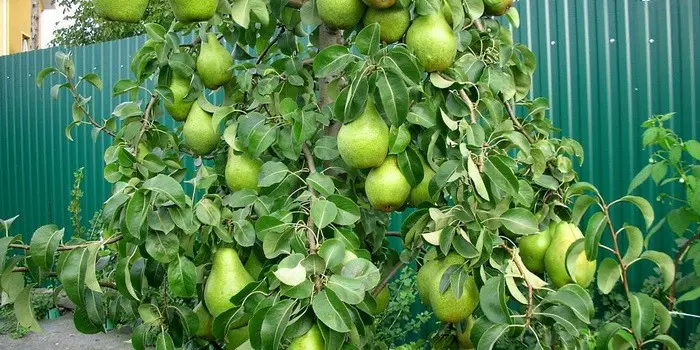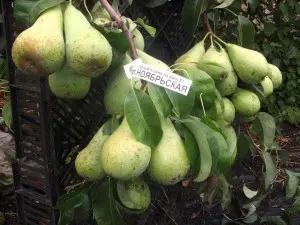One of the most favorite fruits after apples is the pear. Due to unpretentiousness in care and climatic resistance, the pear has become widespread. This fruit tree has a wide variety of varieties, one of which is the November pear. This pear has a number of characteristics that favorably distinguish it from the rest.
Variety description
Pear Noyabrskaya has several names, namely it is also called Noyabrskaya Moldova or Winter. It is a reference variety. This species was bred as a result of crossing Dekanka Zimnyaya and Ussuriyskaya pears. This fruit tree has been known since 1950.
The tree grows quite tall, has a wide pyramidal and rounded crown. Skeletal branches grow from the trunk at an angle of 900. Dense branching is characteristic. Its shoots are greenish-burgundy in color, rather thick and cranked. Fruit formations develop on two- or three-year-old wood, they look like simple annelids or shortened twigs.
What this variety looks like can be seen in this photo.

The leaves are round or oval in shape, but dense and elongated. They are of medium size. Their edge is entire or finely serrated. The color of the leaf blade is different: it is dark green above and light green below. The omission is not typical.
Planting seedlings should be carried out in spring or autumn (but only before frost). During the first year, after planting, it does not need pruning. Light rejuvenation by pruning should be done once every two to four years. To increase the size and volume of fruiting, it is necessary to fertilize with potash fertilizers and a 0,4% solution of urea.
Fruiting begins from two to three years, after planting a seedling. But massively begins to bear fruit only in the fifth year. Characterized by a regular yield. It is annual and plentiful (about 70 c/ha on average). Fruits are formed in different sizes and their weight ranges from 70 to 360 g (the mass depends on the care and climatic features of the growing zone). Their shape is ovoid. Pears are unequal-sided and ribbed, as well as with deep grooves. The peel has a yellowish-green color with a characteristic burgundy blush, and numerous light brown dots are visible under the skin. It is thick in texture. When harvested, it has a greenish tinge, and when ripe it becomes pale yellow. Blush forms on the sunny side. The funnel is shallow and narrow. The upper base is blunt below and has a slight indentation. The bottom base is blunt, slightly uneven and has a cut-off appearance. The pear is divided by veins into unequal slices. The stalk is thick and curved, the length, like the width, is medium, has a dark brown color. The cup is narrow and small. Sepals sparse and narrow, directed to the sides. The flesh is white, oily and juicy. It has a pleasant aroma and a pronounced sweet and sour taste. In terms of taste, it is similar to the fruits of the Noyabrsk beauty pear.
It is considered a late autumn or early winter variety. Pears ripen in late September, October or early November. They do not fall even during the monsoon rains. The fruits become suitable for consumption in a month, after ripening. In a cool place they are able to lie until December-January, and in a freezer until the end of winter (there were cases when they were preserved until April). After defrosting, the taste is preserved. They make excellent jams, compotes, marmalade and dried fruits. Due to this, this variety has a lot of positive reviews.
Pears of this variety contain the following substances: sugars (10,8%), tannins (0,5%), titratable acids (0,9%), pectin substances (0,4%).
The November pear is characterized by precociousness. An excellent combination with quince rootstocks is described.
Pollinators for the November pear are Williams summer, Hoverla, Clapp’s Favorite, Conference.
Pear Noyabrskaya has increased resistance to many fungal diseases and scab. The degree of immunity to bacterial burn is also very high. It is characterized by high winter hardiness, especially the root system. Winter hardiness is constant when growing on hills.
This fruit tree can be found in almost all EU countries, Belarus, Ukraine and Our Country.
Video “Pear November”
In this video, you can clearly see the parameters and characteristics of this tree.
Advantages and disadvantages
Like any other variety of any fruit tree, the November pear has both advantages and disadvantages.

Gardening benefits include:
- excellent taste characteristics of fruits;
- well suited for various preservations;
- good yield;
- stability in fruiting;
- the yield is quite high;
- strong attachment of fruits;
- duration of storage of pears;
- during storage, positive taste qualities are preserved, as well as juiciness, elasticity;
- transportability;
- high frost resistance;
- high fire resistance.
In addition to such an inspiring list of positive advantages, the November pear has only minor disadvantages:
- fruits can be formed both large and small;
- the appearance of the pears is inexpressive.
Thanks to its excellent characteristics, the November pear is a very popular variety. And high winter hardiness and low susceptibility to fungal diseases will give odds to many other varieties.









